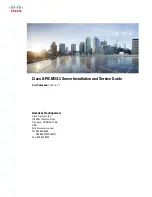
Clearspan® Product Overview R19
Aastra – 2740-007
2014 Clearspan® is a Registered Trademark of Aastra Technologies Ltd.
Page 24 of 93
Figure 12. SBC Cross Coupling.
2.2.3
Network Redundancy
Clearspan offers network-level redundancy, which is a capability not possible with most circuit-
switched equipment. Using various schemes, Clearspan can offer continued service in the event of
floods, massive electrical outages, or any other disasters that affect a particular data center, central
office, or geographic region. This enhanced service availability is achieved through common
signaling interface redundancy, separate access and network interface redundancy, and redundant
path topology.
Clearspan makes a clear distinct
ion between signaling events from “network devices” (for example,
soft-switches, network gateways, proxy servers, management systems) and signaling events from
“access devices” that interface with the system from the user premises (for example, IADs, access
gateways, IP phones, web browsers). Administrators can choose to deploy both access and
network elements on the same physical interface plane, or they can choose to separate them, for
security purposes, onto separate physical interfaces.
In either configuration, administrators can also choose the redundant addressing scheme that best
fits the topology of their network. Clearspan supports two IP addressing topologies:
redundant
paths,
whereby each redundant network interface cards pair is configured on the same IP subnet;
or
redundant routes
, whereby each network interface card is configured with unique routable IP
addresses on separate IP subnets.
2.2.4
Geographic Redundancy
It is not enough to simply deploy redundant network elements. Aastra assembles these elements
into a cohesive, highly available solution.
One problem that arises when providing end-user services is the management of persistent profile
data and run-time session states. Conventional redundancy solutions usually solve this problem
with proprietary hardware, which make the solutions expensive and do not offer any level of
geographic redundancy.
The solution for these problems in a Clearspan system begins with database replication technology
that keeps data in sync across servers in the network. Secondly, through a proven technology
called “Dynamic User Hosting”, a user’s endpoint binds to any appropriate Application Server in the
















































